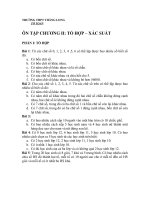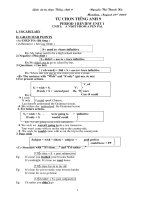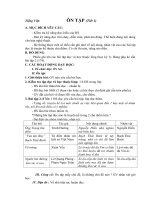ôn tập cuối kỳ hóa đại cương
Bạn đang xem bản rút gọn của tài liệu. Xem và tải ngay bản đầy đủ của tài liệu tại đây (91.64 KB, 4 trang )
4105
Question 1
Use the information provided to calculate the
standard enthalpy of formation (kJ·mol–1) of
acetylene, C2H2(g):
C2H2(g) + 5/2O2(g) 2CO2(g) + H2O(l)
∆H˚ = –1299.5 kJ
C(s) + O2(g) CO2(g) ∆H˚ = –393.5 kJ
H2(g) + 1/2O2(g) H2O(l) ∆H˚ = –285.8 kJ
a) –1978.8
b) –1121.4
c) 226.7
d) 453.4
Question 2
Which statement is always true for a spontaneous
reaction?
a) The entropy change for the system is
negative.
b) The enthalpy change for the system is
negative.
c) The entropy change for the universe is
positive.
d) The free energy change for the system is
positive.
Question 3
Arrange the following reactions in order of
increasing ∆S value (All substances are in gaseous
state):
N2 + O2 = 2NO
(1)
2CH4 = C2H2 + 2H2 (2)
2SO2 + O2 = 2SO3
(3)
a) 1,2,3
b) 2,1,3
c) 3,1,2
d) 2,3,1
Question 4
Which of the following reactions, in the same
conditions, have the largest and the smallest value of
∆S:
N2(g) + O2(g) = 2NO(g)
(1)
KClO4 (s) = KCl (s) + 2O2 (g) (2)
C2H2 (g) + 2H2 (g) = C2H6 (g) (3)
a) 1, 2
b) 2, 3
c) 2, 1
d) 3, 1
Question 5
Arrange the following substances (1 mole of each) in
order of increasing the value of entropy at 25°C and
1 atm: (I) Ne(g), (II) SO2(g), (III) Na(s), (IV)
NaCl(s), (V) H2(g).
Page 1
a) (I)<(II)< (V)<(III)<(IV)
b) (III)<(IV)< (I)<(II)< (V)
c) (III)<(IV)< (I)<(V)< (II)
d) (IV)<(III)< (I)<(V)< (II)
Question 6
Which statement is correct at 25˚C and 1 atm
pressure?
a) ∆G˚f for Hg(l) = 0 kJ.mol–1
b) ∆H˚f for I2(g) = 0 kJ.mol–1
c) ∆H˚f for H2O(l) = 0 kJ.mol–1
d) S˚ for O2(g) = 0 J.mol–1.K–1
Question 7
The enthalpy of fusion for NaF(s) at its melting point
(992˚C) is 29.3 kJ.mol-1. What is the value of ∆S˚ fus in
J.mol-1.K-1?
a) 43.2
b) 33.9
c) 29.5
d) 23.2
Question 8
Choose the correct answer for the reversible reaction
in certain conditions having ∆Go>0
a) The equilibrium constant of the reaction is
smaller than 1
b) The equilibrium constant of the reaction is
greater than 1.
c) The reaction in those conditions is reactantfavored.
d) (a) and (c) are correct.
Question 9
For a reaction at constant pressure to be spontaneous,
which relationship must be correct?
a) ∆Hrxn < 0
b) ∆Grxn < 0
c) ∆Srxn < 0
d) ∆Suniv < 0
Question 10
Calculate ∆Go298 of the following reaction:
2A(g) + B(g) C(g)
Substance
∆Hof (kJ/mol)
So(J/mol.K)
A (g)
191
244
B (g)
70.8
300
C( g)
-197
164
a) – 160.15 kJ
b) + 956 kJ
c) – 463, 85kJ
d) Another answer
4105
Question 11
For the following reaction,
C2H6 (g) → C2H4 (g) + H2 (g)
∆H = +137KJ/mol, ∆S0= +120J/(mol.K). This
reaction is:
a) spontaneous at all temperatures
0
b) spontaneous only at high temperature
c) spontaneous only at low temperature
d) nonspontaneous at all temperatures
Question 12
Choose the correct answer.
The transition of water from the liquid to the gaseous
state at 110oC:
a) ∆G>0, ∆H<0, and ∆S=0
b) ∆G<0, ∆H>0, and ∆S>0
c) ∆G<0, ∆H>0, and ∆S<0
d) ∆G>0, ∆H>0, and ∆S>0
Question 13
At the certain conditions, K c=200 for the following
reaction:
A(aq) + B(aq) ⇌ 2C(aq). The following
concentrations were detected in a mixture. Which
direction must the reaction proceed for equilibrium to
be established? CA=CB=10-3M, Cc=0.01M.
a) The system transfers in reverse direction.
b) The system transfers in forward direction.
c) The system is at the equilibrium state.
d) Unable to predict the state of the reaction.
Question 14
Consider the reaction carried out at constant volume:
2SO2(g) + O2(g) 2SO3(g).
For initial concentrations of SO2 and O2 of 2.0 M and
1.5 M, respectively. After the equilibrium state is
established, the O2 concentration is 0.80 M. What is
the value of Kc for this reaction?
a) 6.8
b) 2.9
c) 0.34
d) 0.15
Question 15
The ∆G°298 the following reaction is 2.60 J/mol.
H2(g) + I2(g) ⇌ 2HI(g)
When the partial pressures of H 2(g), I2(g), HI(g) are
4.26 atm, 0.024 atm, and 0.23 atm, respectively.
Calculate ∆G of above reaction at 25oC.
a) -1629.9 kJ/mol;
b) -1.63 kJ/mol;
c) +0.97 kJ/mol;
d) +0.97 kJ/mol;
Page 2
Question 16
The gaseous compound NOBr decomposes according
to the following equation at 350 K, the equilibrium
constant, Kp, is 0.15. What is the value of ∆G˚?
NOBr(g) NO(g) + 1/2 Br2(g)
a) –5.5 × 103 J/mol
b) –2.4 × 103 J/mol
c) 2.4 × 103 J/mol
d) 5.5 × 103 J/mol
Question 17
A 2.0 L container is charged with a mixture of 6.0
moles of CO(g) and 6.0 moles of H2O(g) and the
following reaction takes place: When equilibrium is
reached the [CO2] = 2.4 M. What is the value of K c
for the reaction?
CO(g) + H2O(g) CO2(g) + H2(g)
a) 16
b) 4.0
c) 0.25
d) 0.063
Question 18
For the synthesis of ammonia, K c is 1.2 at 375 ˚C
N2(g) + 3 H2(g) 2 NH3(g),
What is Kp at this temperature?
a)
4.1 × 10–8
b)
4.2 × 10–4
c)
1.3 × 10–3
d)
3.4 × 103
Question 19
The equilibrium system, N2O4(g) 2NO2(g), has Kp
= 11. For which equilibrium system is Kp = 0.091?
a) 2NO2(g) N2O4(g)
b) NO2(g) 1/2 N2O4(g)
c) 2N2O4(g) 4NO2(g)
d) 1/2 N2O4(g) NO2(g)
Question 20
The following exothermic reaction is at equilibrium:
2 A(g) + B(g) ⇌ 4D (g)
What is condition for product favored?
1) Increase the temperature
2) Add more D
3) Decrease the volume of the bottle
4) Decrease the temperature
5) Add more A
6) Increase the volume of the bottle
a)
1, 3, 5
b)
4,5,6
c)
2,3
d)
5 and 6 only
Question 21
4105
Choose the correct expression :
Consider the equilibrium : 2NO2(g) = N2O4(g)
∆Ηo298= -14kcal. In four following statements, the
color (brown) of NO2 will be darkest when:
a) Heating to 373K.
b) Cooling to 273K
c) Increase pressure.
d) Keep at 298K.
Question 22
The reaction A(g) ⇌B(g) + C(g) at 300oC has
Kp=11.5; at 500oC has Kp=33. What is condition for
product-favored?
a) Heating
b) Cooling
c) Compreesing
d) (a) and (c)
Question 23
Choose the correct answer
Consider
the
system
at
equilibrium:
NH4HS(s) NH3(g) + H2S(g) ∆H > 0
Factors which favor the formation of more H2S(g)
include which of the following?
I - adding a small amount of NH4HS(s) at constant
volume
II - increasing the pressure at constant temperature
III -increasing the temperature at constant pressure
a) I only
b) III only
c) I and II only
d) I and III only
Question 24
Molarity is defined as the __________.
a) moles solute/moles solvent .
b) moles solute/kg solution.
c) moles solute/liters solution.
d) moles solute/kg solvent
Question 25
As the concentration of a solute in a
solution increases, the boiling point of the
solution ________ and the vapor pressure of
the solution _________.
a) increases, increases
b) increases, decreases
c) decreases, increases
d) decreases, decreases
Question 26
Choose the correct answer.
A solution with a concentration higher than the
solubility is __________.
a) unsaturated
b) supercritical
c) saturated
Page 3
d) supersaturated
Question 27
Pressure has an appreciable effect on the solubility of
__________ in liquids.
a) gases
b) solids
c) liquids
d) solids and liquids
Question 28
Calculate the freezing point of a 0.055 m aqueous
solution of glucose. The molal freezing-pointdepression constant Kf of water is 1.86 oC/m.
a) 0.0286
b) 0.1023
c) -0.0562
d) -0.1023
Question 29
What is the molality of a solution made by
dissolving 36.0 g of glucose (C6H12O6, M =
180.2) in 64.0 g of H2O?
a) 0.0533
b) 0.200
c) 0.360
d) 3.12
Question 30
What is the molality of a solution made by
dissolving 36.0 g of glucose (C6H12O6, M =
180.2) in 64.0 g of H2O?
a) 0.0533
b) 0.200
c) 0.360
d) 3.12
Question 31
A 200g solvent containing A (g) glucose (molecular
weight M). Kf is the molal freezing-point-depression
constant of the solven. Which expression is true
about ∆Tb:
a) ∆Tb = 5 Kf.(A/M)
b) ∆Tb = Kf.(A/M)
c) ∆Tb = 1/5 Kf.(A/M)
d) ∆Tb = Kf.A
Question 32
Calculate the vapor-pressure lowering of water when
5.67 g of glucose, C6H12O6, is dissolved in 25.2 g of
water at 25 oC. The vapor pressure of water at 25 oC is
23.8 mmHg.
a) 23.276 mmHg
b) 0.7497 mmHg
c) 33.32 mmHg
4105
d) 0.524 mmHg
Question 33
Dissolving 5g of each following compounds into
500g of water: C6H12O6, C12H22O11 and C3H5(OH)3.
Arrange the following solutions in order of
increasing boiling point (all of those compound are
non-vaporized)
a) C12H22O11 < C6H12O6 < C3H5(OH)3
b) Cannot be arranged.
c) C3H5(OH)3 < C6H12O6 < C12H22O11
d) C12H22O11 < C3H5(OH)3 < C6H12O6
Question 34
A 5.1 g sample of CaCl2 is dissolved in a beaker of
water. Which of the following statements is true of
this solution?
a) The solution will freeze at a lower temperature
than pure water.
Page 4
b) The solution has a higher vapor pressure than
pure water.
c) The solution will boil at a lower temperature
than pure water.
d) Water is the solute in this solution
Question 35
Choose the correct statement about the coefficient k
in the following equation: ∆T = k× Cm (Cm: molality)
a) k is a constant depends on the concentration of
solute, temperature and the nature of solvent.
b) k is a constant depends on temperature and the
nature of solvent.
c) k is a constant only depends on the nature of
solvent.
d) k is a constant depends on the nature of both
solute and solvent









